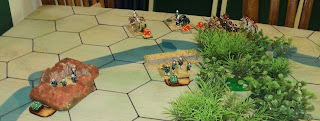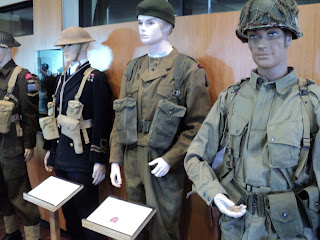...
The Turkowaz depredations upon the Ruberian Imperium of Rajistan, in the Sangrian sub-continent, had in recent times become more than could be contained by the overstretched border command of Sir Redfers Carmine, and in consequence more than a mere nuisance.
'The overbearing Sultan Azraq Arslan must be taught a sharp lesson!' quoth the choleric General and Vice-Regent Sir Grinmore Scarlett, '... and I am the one to administer it, by the Powers!' After several weeks of preparation, General Scarlett assembled a Division sized corps of all arms. With this Expeditionary Division, he undertook to enter Medifluvia, advance up the famous Pardis River, take the fabled city of Sakhdad, strip the place of its wealth and raze it to the ground. By, as he averred, the Powers.
In the natural course of things, the weeks of assembling troops, supplies and associated impedimenta did not go unnoticed in Sakhdad, the seat of the local Medifluvian Governor, the Bey of Bassorah. Clearly, this was going to be far beyond his local levies and few regular forces to cope with. An appeal was despatched betimes to the Sultan in his Settee capital, Ionople. The normally somnolent Sultan, apt to be awakened into action by the threat of violence to his realm, sent his best commander Nasr-ed-Din Pasha, with instructions to pick up such troops as he could along his journey to the distant province, and bring the Ruberians and their Rajistan sepoys to a halt well south of Sakhdad, and to destroy them in the desert.
Nasr-ed-Din managed on the march to gather enough infantry to form three small Divisions, though he could not hide from himself their general lack of training, even such as might have been got on the march. His cavalry were of better mettle, and his artillery good. His best troops, few as they were, were to be found in the personal entourages of his commanders. Arriving at Sakhdad, he continued on south to meet the Frankish foe.
 |
Area of Hak battlefield. The cartographer has mislabelled the
River Pardis as 'Tigris'. The square marked 'D' represented a
small column that General Scarlett decided against sending.
|
On the Ruberian side, but for delays that added weeks to the operation, the advance had proceeded without trouble, nor any real sign of the enemy. At last the Ruberians reach the point along the River Pardis where the stream made a sharp loop, such that for a few miles along its length one might stand on the west bank and watch the sun set behind the east. Nestled in this loop was the desert market town of Hak. It was in this area that Nasr-ed-Din had chosen to take his stand (see map).
The Pasha had with him:
Medifluvian Defence Army: General Nasr-ed-Din Pasha (TURQUOISE) 6SP
35th Division: Duya-ed-Din Pasha (and entourage) (1SP - Elite)
137th Regiment (4SP - Poor {levy})
138th Regiment (4SP - Poor)
139th Regiment (4SP - Poor)
140th Regiment (4SP - Poor)
35th Mountain Artillery (2SP - Average)
37th Division: Abdul Kerim Emir (1SP - Elite)
145th Regiment (4SP - Poor)
146th Regiment (4SP - Poor)
147th Regiment (4SP - Poor)
148th Regiment (4SP - Poor)
37th Field Artillery (2SP- Average)
38th Division: Ali Sait Akbaytogan (1SP - Elite)
149th Regiment (4SP - Poor)
150th Regiment (4SP - Poor)
151st Regiment (4SP - Poor)
152nd Regiment (4SP - Poor)
38th Mountain Artillery (2SP - Average)
14th Cavalry Division: Ahmed Fayzi Pasha (1SP - Elite)
40th Cavalry Regiment (3SP - Average)
41st Cavalry Regiment (3SP - Average)
42nd Cavalry Regiment (3SP - Average)
13th Field Artillery: (2SP - Average)
24 units; Median 12
75 Strength points; Exhaustion Point -25.
 |
Medifluvian Defence Army
|
Rajistan Expeditionary Division (RED): Major-General Sir Grinmore Scarlett 6SP
16th 'Poona' Brigade: Brigadier Sir Rubeus Redmayne (1SP - Elite)
2nd Dorsets (4SP - Elite)
20th Duke of Cambridge's Own (4SP - Average)
114th Duke of Wellesley's Rifles (4SP - Average)
117th Madasahatta Infantry (4SP - Average)
'Poona' Gatling (MG) Company (2SP - Average)
17th 'Ahmednagar' Brigade: Brigadier Sam Vermilion-Jones (1SP - Elite)
1st Ox and Bucks (4SP - Elite)
22nd Punchnjab Infantry (4SP - Average)
103rd Madasahatta Infantry (4SP - Average)
119th Myulshu Infantry (4SP - Average)
'Ahmednagar' Gatling Company (2SP - Average)
18th 'Belgaum' Brigade: Col. Sir Redfers Carmine, Bart. (1SP - Elite)
2nd Norfolk Infantry (4SP - Elite)
7th Duke of Norfolk's Own (4SP - Average)
110th Madasahatta Infantry (4SP - Average)
120th Rajinbul Infantry (4SP - Average)
'Belgaum' Gatling Company (2SP - Average)
6th Cavalry Brigade: Brigadier Salmond Lord Garnet (1SP - Elite)
7th Lancers (3SP - Elite)
16th Dragoons (3SP - Elite)
33rd Queen Victoria's Own Light Horse (3SP - Average)
Gatling Detachment, RHA (2SP - Average)
Division Artillery:
'X' Mountain Artillery Brigade (2SP - Average)
1st Rajistan Mountain Artillery (2SP - Average)
5th Hants Field Howitzer Battery (2SP - Average)
27 Units; 14 Median.
81 Strength Points; Exhaustion point -27SP.
Rajistan Expeditionary Division (RED)
The knowledgeable military historian might observe an uncanny resemblance to the Battle of Kut, an incident during the course of the campaign conducted by a certain Major-General Sir Charles Vere Ferrers Townshend in Mesopotamia, 1915-16. I've had this project in the pipeline for several months, now, and finally got to play it out. I was hoping to involve 'Jacko', using a very slightly adapted Portable Wargames rule set for the 19th Century, from Bob Cordery's first book of the series, but as he was unavailable, played it out solo.
More, later...
To be continued...



































